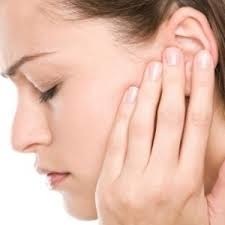
 feeling of fullness or pressure in the ear, congested or stuffed ears, specifically when doing things like yawning or swallowing. Can originate from the outer ear, the middle ear, the inner ear, or due to problems in the internal auditory canal (IAC) and cerebellopontine angle area. Cerumen, debris, or hair in the ear canal can contribute to a sensation of fullness in the ear. In addition, some outer ear canal infections, such as fungal or yeast infections, lead to symptoms of ear fullness. These problems can be easily detected by microscopy and resolved by thorough cleaning of the ear canal by instrumentation or aspiration. Problems in the middle ear can include fluid, negative pressure due to a Eustachian tube dysfunction, an abnormally open (patulous) Eustachian tube, fixation of the ossicular chain or a mass or cholesteatoma in the middle ear. Increased inner ear fluid pressure, as seen in hydrops or Ménière’s disease can also result in a sensation of fullness. Often patients having a low frequency sensorineural hearing loss or experiencing a sudden sensorineural hearing loss will have a sensation of pressure in the ear. Other causes can include tumors (identifiable with an MRI or CT scan) or temporomandibular joint inflammation (TMJ).
Comments
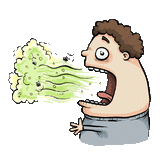 Bad breath, fetor oris or halitosis is a symptom when a noticeably unpleasant odors are exhaled in respiration. Types of odors depend on the food eaten (such as garlic, onions, meat, fish, and cheese), hydration, body mass, smoking, alcohol consumption and other exposures. Low calorie dieting leads to acetone-like odors. Diseases associated with unpleasant breath include liver (fishy), kidney failure (ammonia-like), cystic fibrosis (acidic). Aging breath could produce cardboard-like smell resembling stale beer. About 20% of the general population are reported to suffer from foul-smelling breath to some degree. 5‑72% of people feeling that they have bad breath, have no genuine halitosis. 90% of those who is diagnosed with halitosis have it because of their oral bacteria below the gum-line and on the back of the tongue. The remaining 10% is accounted for by many conditions, including disorders in the nasal cavity, tonsil stones, sinuses, throat, lungs, esophagus, stomach, pancreatic insufficiency, food sensitivities or metabolic disorders like TMAU.  The unpleasant smell of human body usually associated with stale perspiration. Many organic and inorganic substances, byproducts of human and microbial metabolism, are released in the person's sweat, breath, urine and other fluids and gases, giving off a strong smell. Odors could be caused by disease (for example, diabetes leads to sweetish odor; kidney: ammonia-like; TMAU: dead-fish, urine-like or fecal; liver: sweet, mousy and fishy odors), infection (e.g., blue-green pus caused by Pseudomonas aeruginosa: grape-like; TB: tar-like; Scrofula: stale beer, yellow fever: butcher's shop), metabolic disorders or temporary problems (issues in cholesterol metabolism: rubber-like; menstrual period: tinny), imbalance or overgrowth of gut microbiota, hormonal imbalance, allergies, diet and medications, prior exposures to strong smells or poor hygiene. See also Aurametrix summaries for Acidic smell; Ammoniacal odor; Bad breath; Burning smell; Chemical odor; Fatty odor; Fecal odor; Fishy smell; Foot odor; Musty odor; Old book smell; Rancid butter odor; Salty odor; Sulfur odor; Sweetish odor; Vaginal odor; Wet dog odor.  Injury creating area of discolored skin on the body, caused by a blow or impact rupturing underlying blood vessels without damaging the skin. Medically speaking, bruise is a contusion, an injury to tissue usually without laceration, and a type of hematoma of tissue in which capillaries and possibly venules are damaged by trauma allowing blood to seep just under the skin. Easy bruising can occur because of deficient blood-clotting elements or when the blood vessels are weakened by diseases (such as scurvy caused by a deficiency of vitamin C), medications (such as aspirin, corticosteroids, coumadin, clopidogrel, prednisone, and prednisolone), supplements (fish oil, ginkgo), nutrient deficiencies (vitamins K, E, C, iron), low estrogen levels (pregnancy, perimenopause, 1st half of menstrual cycle), and aging - because of thinning skin and weakening capillaries. 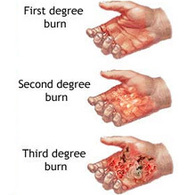 injury caused by exposure to heat or flame, electricity, chemicals, light, radiation or friction. 1st degree burn may lead to red skin and some swelling, 2nd degree leads to blisters and severe pain, 3rd degree burns involve all layers of the skin and cause permanent tissue damage, while 4th degree damage muscle and can be fatal. The treatment of burns may include the removal of dead tissue (debridement), applying dressings to the wound, antibiotics, and skin grafting. 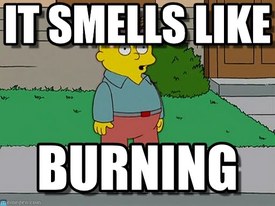 Smoky smell resembling burnt substances. Burning smell could be an olfactory hallucination or a real smell indicating a problem in the environment or human body. Could be a part of olfactory aura and the most common smell reported before a migraine episode (putrid smoky odors or scent resembling smoke, burnt plastic, burning wood, burnt toast or cigarette smoke). Other less common smells include toxic-smelling aromas, sewer-like stenches and decomposed garbage. Chemical substances associated with burning smells include sulfur dioxide and volatile hydrocarbons. The smoky odor character is most consistently associated with hydroxy and methoxy indanones and partially with methyl and methoxy phenols. Burnt odors are associated with furans and alkyl benzaldehydes. The oxidized oily character is usually ascribed to alkenones, dienones, hydroxy cyclocarbonyls, and indanones. Irritation factors seem most frequently to be associated with the lower molecular weight phenols. Some benzeldehydes and methoxy benzenes may also contribute to this sensation. While some unsaturated aldehydes contribute to a portion of the exhaust odor complex, the most abundant exhaust aldehydes do not appear to contribute significantly. Neither sulfur nor nitrogen containing species contribute to the smoky-burnt odor complex and exhaust odors. Ethyne, ethene and benzene were found to make up well over 80% of the non-methane hydrocarbons for efficient flame combustion of wood. The proportions for low-temperature smouldering are similar to those of environmental tobacco smoke. The hydrocarbons from wood burning differ from those in traffic-polluted urban air by higher proportions of ethene and alkadienes and lower proportions of alkanes and alkylbenzenes which are emitted as unburnt petrol components. Ethyne may be a suitable tracer hydrocarbon for emissions from efficient wood-burning installations. The high proportions of the genotoxic hydrocarbons ethene, propene, 1,3-butadiene and benzene are of concern with respect to health hazards 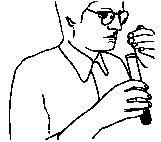 plastic-like odor or smells like industrial strength cleaner, bathroom cleaner, kitchen cleaner, sulfurous and medicinal. Examples of compounds with chemical odor are methyl-p-xylene, (Z)-2-penten-1-ol and fucoserratene that smell like plastic, methanethiol and dimethyl sulfide - that could smell like gasoline. Isoprene in breath associated with problems in cholesterol metabolism could smell like new rubber tubing.  feeling of uncomfortably chilled feet, no warmth, cold sensation to the feet. It could happen because of poor circulation, disorders of the nervous system, decreased metabolism from hypothyroidism (a low thyroid condition), diabetes, arteriosclerosis, peripheral vascular disease, Raynaud's phenomenon, neuropathy, or exposure to cold and frostbite. As people may get cold feet when they are nervous, expression to "get cold feet" means to lose your desire or nerve to do something, be too fearful to undertake or complete an action. 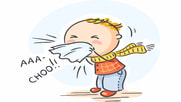 Viral infection that enters the body through the mouth, eyes or nose and throat. Symptoms such as scratchy throat, congestion and runny nose usually appear one to three days after exposure to a cold-causing virus. Then sneezing and a cough usually develops. The common cold tends to clear up on its own in three to four days although cough and post-nasal drip may linger.  irregular and infrequent or difficult evacuation of the bowels, generally described as having fewer than three bowel movements a week. It is usually noticed when there are changes to harder stool consistency, the presence of pellets, straining or feeling of incomplete evacuation, and a sensation of “want, but can’t.” Though occasional constipation is very common, some people experience chronic constipation that can interfere with their ability to go about their daily tasks. Chronic constipation may also cause excessive straining to have a bowel movement and other signs and symptoms. In many cases simple adjustment of diet, keeping active and regular toilet habits (not skipping it, finding enough time and privacy, or squatting instead of sitting) could help,. But there might be other underlying causes including hormonal (diabetes, pregnancy, thyroid issues), muscle weakness, neurological problems and blockages in the colon or rectum. |
Categories
All
|
